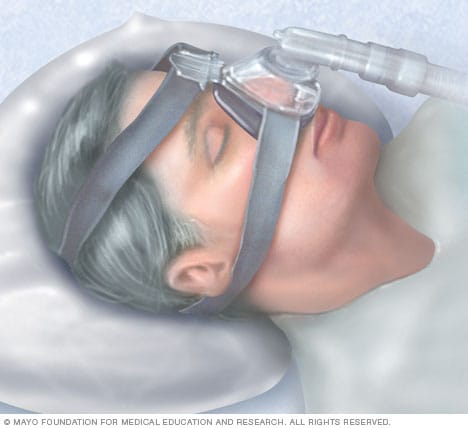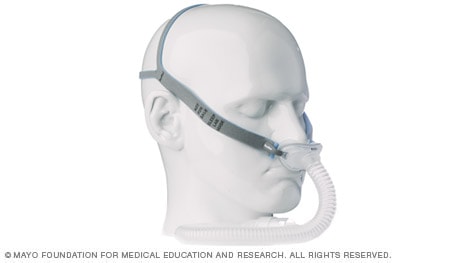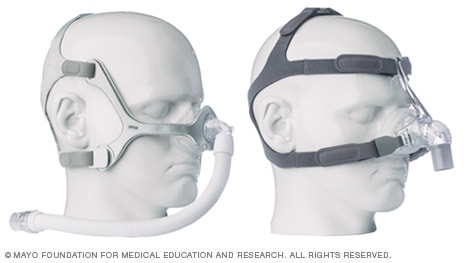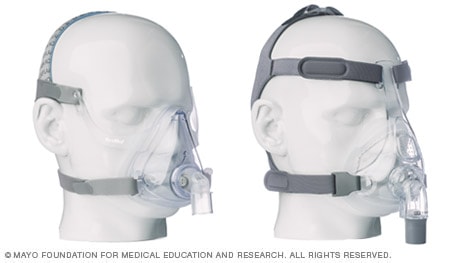Diagnosis
Your health care provider may make an evaluation based on your symptoms and a sleep history, which you can provide with help from someone who shares your bed or your household, if possible.
You're likely to be referred to a sleep disorder center. There, a sleep specialist can help you determine your need for further evaluation.
An evaluation often involves overnight monitoring of your breathing and other body functions during sleep testing at a sleep center. Home sleep testing also might be an option. Tests to detect sleep apnea include:
- Nocturnal polysomnography. During this test, you're hooked up to equipment that monitors your heart, lung and brain activity, breathing patterns, arm and leg movements, and blood oxygen levels while you sleep.
-
Home sleep tests. Your health care provider might provide you with simplified tests to be used at home to diagnose sleep apnea. These tests usually measure your heart rate, blood oxygen level, airflow and breathing patterns. Your provider is more likely to recommend polysomnography in a sleep testing facility, rather than a home sleep test, if central sleep apnea is suspected.
If the results aren't typical, your provider might be able to prescribe a therapy without further testing. Portable monitoring devices sometimes miss sleep apnea. So your health care provider might still recommend polysomnography even if your first results are within the standard range.
If you have obstructive sleep apnea, your health care provider might refer you to an ear, nose and throat specialist to rule out a blockage in your nose or throat. An evaluation by a heart specialist, known as a cardiologist, or a doctor who specializes in the nervous system, called a neurologist, might be necessary to look for causes of central sleep apnea.
Treatment
Continuous positive airway pressure (CPAP)

Continuous positive airway pressure (CPAP)
To eliminate snoring and prevent sleep apnea, a health care professional may recommend a device called a continuous positive airway pressure (CPAP) machine. A CPAP machine delivers just enough air pressure to a mask to keep the upper airway passages open, preventing snoring and sleep apnea.
For milder cases of sleep apnea, your health care provider may recommend only lifestyle changes, such as losing weight or quitting smoking. You may need to change the position in which you sleep. If you have nasal allergies, your provider may recommend treatment for your allergies.
If these measures don't improve your symptoms or if your apnea is moderate to severe, a number of other treatments are available.
Certain devices can help open a blocked airway. In other cases, surgery might be necessary.
Therapies for OSA
-
Continuous positive airway pressure (CPAP). If you have moderate to severe obstructive sleep apnea, you might benefit from using a machine that delivers air pressure through a mask while you sleep. With CPAP (SEE-pap), the air pressure is somewhat greater than that of the surrounding air and is just enough to keep your upper airway passages open, preventing apnea and snoring.
Although CPAP is the most common and reliable method of treating sleep apnea, some people find it cumbersome or uncomfortable. Some people give up on the CPAP machine. But with practice, most people learn to adjust the tension of the straps on the mask to obtain a comfortable and secure fit.
You might need to try more than one type of mask to find one that's comfortable. Don't stop using the CPAP machine if you have problems. Check with your health care provider to see what changes can be made to increase your comfort.
Additionally, contact your provider if you're still snoring or begin snoring again despite treatment. If your weight changes, the pressure settings of the CPAP machine might need to be adjusted.
- Other airway pressure devices. If using a CPAP machine continues to be a problem for you, you might be able to use a different type of airway pressure device that automatically adjusts the pressure while you're sleeping (auto-CPAP). Units that supply bilevel positive airway pressure (BPAP) also are available. These provide more pressure when you inhale and less when you exhale.
-
Oral appliances. Another option is wearing an oral appliance designed to keep your throat open. CPAP is more reliably effective than oral appliances, but oral appliances might be easier to use. Some are designed to open your throat by bringing your jaw forward, which can sometimes relieve snoring and mild obstructive sleep apnea.
A number of devices are available from your dentist. You might need to try different devices before finding one that works for you.
Once you find the right fit, you'll need to follow up with your dentist repeatedly during the first year and then regularly after that to ensure that the fit is still good and to reassess your symptoms.
You'll likely read, hear or see TV ads about different treatments for sleep apnea. Talk with your health care provider about any treatment before you try it.
Surgery for OSA
Surgery may be an option for people with OSA, but usually only after other treatments have failed. Generally, at least a three-month trial of other treatment options is suggested before considering surgery. However, for a small number of people with certain jaw structure problems, surgery is a good first option.
Surgical options might include:
-
Tissue removal. During this procedure (uvulopalatopharyngoplasty), a surgeon removes tissue from the rear of your mouth and top of the throat. Your tonsils and adenoids usually are removed as well.
This type of surgery might be successful in stopping throat structures from vibrating and causing snoring. It's less effective than CPAP and isn't considered a reliable treatment for obstructive sleep apnea.
Removing tissues in the back of the throat with radiofrequency energy (radiofrequency ablation) might be an option for those who can't tolerate CPAP or oral appliances.
- Tissue shrinkage. Another option is to shrink the tissue at the rear of the mouth and the back of the throat using radiofrequency ablation. This procedure might be used for mild to moderate sleep apnea. One study found this to have effects similar to that of tissue removal, but with fewer surgical risks.
- Jaw repositioning. In this procedure, the jaw is moved forward from the remainder of the face bones. This enlarges the space behind the tongue and soft palate, making obstruction less likely. This procedure is known as maxillomandibular advancement.
- Implants. Soft rods, usually made of polyester or plastic, are surgically implanted into the soft palate after numbing with a local anesthetic. More research is needed to determine how well implants work.
- Nerve stimulation. This requires surgery to insert a stimulator for the nerve that controls tongue movement (hypoglossal nerve). The increased stimulation helps keep the tongue in a position that keeps the airway open. More research is needed.
-
Creating a new air passageway, known as tracheostomy. You may need this form of surgery if other treatments have failed and you have severe, life-threatening sleep apnea. In this procedure, your surgeon makes an opening in your neck and inserts a metal or plastic tube through which you breathe.
You keep the opening covered during the day. But at night you uncover it to allow air to pass in and out of your lungs, bypassing the blocked air passage in your throat.
Other types of surgery may help reduce snoring and contribute to the treatment of sleep apnea by clearing or enlarging air passages:
- Surgery to remove enlarged tonsils or adenoids.
- Weight-loss surgery, also known as bariatric surgery.
Therapies for CSA
- Treatment for associated medical problems. Possible causes of central sleep apnea include heart or neuromuscular disorders, and treating those conditions might help. Other therapies that may be used for CSA include supplemental oxygen, CPAP, BPAP, and adaptive servo-ventilation (ASV).
- Medicine changes. You may be prescribed medicine to help manage your breathing, such as acetazolamide. If medicines are worsening your CSA, such as opioids, your health care provider may change your medicines.
- Supplemental oxygen. Using supplemental oxygen while you sleep might help if you have central sleep apnea. Various forms of oxygen are available with devices to deliver oxygen to your lungs.
-
Adaptive servo-ventilation (ASV). This more recently approved airflow device learns your typical breathing pattern and stores the information in a built-in computer. After you fall asleep, the machine uses pressure to regulate your breathing pattern and prevent pauses in your breathing.
ASV may be an option for some people with treatment-emergent central sleep apnea. However, it might not be a good choice for people with predominant central sleep apnea and advanced heart failure. And ASV is not recommended for those with severe heart failure.

Many CPAP mask options available
Continuous positive airway pressure (CPAP) masks and headgear come in many styles and sizes to comfortably treat your sleep apnea. Everyone has different needs, preferences and face shapes, and sometimes you will need to try different mask styles before you find the one that works the best for you.
Sizes may vary across different mask styles and brands. You may need to try on several styles and sizes to find the best combination of comfort and efficiency.
For example, if you take a small in one type it does not necessarily mean you will need a small in a different brand. Proper sizing is very important to comfort and performance of masks.
Here's a look at a few CPAP mask styles and some possible benefits of each. Work with your doctor and CPAP mask supplier to make sure you have a mask that suits your needs and fits you properly.

Nasal pillow mask
Nasal pillows fit at the nares to supply air pressure.
Might be good if:
- You feel claustrophobic in masks that cover more of your face
- You want a full field of vision for reading or watching TV
- You want to wear your glasses
- You have facial hair that interferes with other masks

Nasal masks
The mask covering the nose supplies air pressure.
Might be good if:
- Your doctor has prescribed a high air pressure setting
- You move around a lot in your sleep

Full-face masks
The mask covering the nose and mouth supplies air pressure.
Might be good if:
- You have nasal obstruction or congestion that makes breathing through your nose difficult
- You breathe through your mouth at night despite a month of trying a nasal mask or nasal pillow interface combined with a heated humidity feature or chin strap or both to keep your mouth closed
More Information
Clinical trials
Explore Mayo Clinic studies testing new treatments, interventions and tests as a means to prevent, detect, treat or manage this condition.
Lifestyle and home remedies
In some cases, self-care might be a way for you to deal with obstructive sleep apnea and possibly central sleep apnea. Try these tips:
- Lose excess weight. Even a slight weight loss might help relieve constriction of your throat. In some cases, sleep apnea can resolve if you return to a healthy weight, but it can recur if you regain the weight.
- Exercise. Regular exercise can help ease the symptoms of obstructive sleep apnea even without weight loss. Try to get 30 minutes of moderate activity, such as a brisk walk, most days of the week.
- Avoid alcohol and certain medicines such as tranquilizers and sleeping pills. These relax the muscles in the back of your throat, interfering with breathing.
- Sleep on your side or abdomen rather than on your back. Sleeping on your back can cause your tongue and soft palate to rest against the back of your throat and block your airway. To keep from rolling onto your back while you sleep, try attaching a tennis ball to the back of your pajama top. There are also commercial devices that vibrate when you roll onto your back in sleep.
- Don't smoke. If you're a smoker, look for resources to help you quit.
Preparing for your appointment
If you or your partner suspects that you have sleep apnea, contact your primary care provider. In some cases, you might be referred immediately to a sleep specialist.
Here's some information to help you get ready for your appointment.
What you can do
When you make the appointment, ask if there's anything you need to do in advance, such as modify your diet or keep a sleep diary.
Make a list of:
- Your symptoms, including any that may seem unrelated to the reason for which you scheduled the appointment, and when they began.
- Key personal information, including family history of a sleep disorder.
- All medicines, vitamins or supplements you take, including doses.
- Questions to ask your doctor.
Take a family member or friend along, if possible, to help you remember the information you receive. Because your bed partner might be more aware of your symptoms than you are, it may help to have your partner along.
For sleep apnea, some questions to ask your doctor include:
- What's the most likely cause of my symptoms?
- What tests do I need? Do these tests require special preparation?
- Is my condition likely temporary or long lasting?
- What treatments are available?
- Which treatment do you think would be best for me?
- I have other health conditions. How can I best manage these conditions together?
- Should I see a specialist?
- Are there brochures or other printed material that I can have? What websites do you recommend?
What to expect from your doctor
Your health care provider is likely to ask you questions, including:
- Have your symptoms been continuous, or do they come and go?
- How severe are your symptoms?
- How does your partner describe your symptoms?
- Do you know if you stop breathing during sleep? If so, how many times a night?
- Is there anything that has helped your symptoms?
- Does anything make your symptoms worse, such as sleep position or alcohol consumption?
What you can do in the meantime
- Try to sleep on your side.
- Avoid alcohol for 4 to 6 hours before bed.
- Don't take drugs that make you sleepy.
- If you're drowsy, avoid driving.